Enjoy DatePsychology? Consider subscribing at Patreon to support the project.
Red Pills, Black Pills, and Physical Attractiveness
The manosphere has within it the ideological subcultures of the red pill and the black pill. The red pill is a form of fringe folk psychology regarding intrasexual dynamics and dating. The black pill is the belief that physical attractiveness is paramount in romantic and sexual success. The red pill is an ideology associated with male dating coaches and podcasters. The black pill is closely associated with the incel (involuntarily celibate) subculture.
Trying to pin down a simple definition of the red pill is like trying to pin down a singular definition of “woke.” Postmodernist frameworks such as the “red pill” or the “woke” do not lend themselves well to straightforward descriptions. Both have high internal ideological heterogeneity. Denizens of both ideological communities will tell you “that is not the red pill,” or “that is not woke,” but anyone familiar with the landscape can recognize both easily.
Making things easier for everyone, there is no shortage of influencers who self-label as “redpilled.” We can simply look to the influencers who call themselves “redpilled” and take them for their word.
Black and red pill ideologies are occasionally at odds with one another. The black pill places a nearly exclusive and total emphasis on physical attractiveness while denying the role of personality in producing romantic outcomes. Conversely, red pill communities overlap with pick-up artistry or learning “game” — they are personality-centered. Within the ideological framework of the red pill men can learn to become successful with women by modifying their behavior or becoming more “alpha.”
Most red pill influencers claim to be successful with women. A few claim to have astronomical “body counts,” or past sexual partner numbers — even despite no “receipts” (pick-up artist terminology for proof), or even despite having been married for decades.
There is no way to verify their claims.
Fitting for a postmodernist ideology, “trust me bro” is the order of the day, and if other men believe the war stories of red pill influencers it’s simply because they want to. There is no rational or evidentiary reason to believe them and, given the extent to which their popularity rests on their claims to being successful with women, we should expect them to have motivation to exaggerate or lie.
If the core claim of the black pill is correct — that physical attractiveness is the primary (and nearly sole) determinant of sexual success — then we should only believe the tales of red pill influencers regarding their sexual conquests insofar as they are conventionally attractive.
However, research does not support this blackpilled belief. A recent meta-analysis I conducted found only a small correlation between physical attractiveness and lifetime number of sexual partners. There are, in fact, a large number of personality and behavioral variables that predict high promiscuity better than physical attractiveness.
Nonetheless, the black pill is not entirely wrong. We know from the growing body of speed-dating studies that physical attractiveness often emerges as the top variable for securing new romantic interest. We see the same thing in research on dating apps: more attractive photos get more matches. Both are contexts that showcase the role of physical attractiveness at zero contact. If a potential mate is entirely unknown the only cue you have is physical attractiveness. Physical attractiveness functions like a gate. The black pill has called this the “looks test” that must be passed and, in general, the black pill is correct on this point.
More physically attractive men will attract more romantic interest and will have more sexual opportunities. If they choose to act on them will determine, in the long run, their “body count.” This is likely why we see such a low correlation between physical attractiveness and the lifetime number of sexual partners. Many men who could be more promiscuous simply aren’t. Most men are forming long-term relationships (serial monogamy) rather than aggressively seeking novelty and racking up numbers.
Further, the bar for the “looks test” is lower than blackpillers believe. Men who are “good enough,” but not exceptionally attractive, may be able to rack up large sexual histories merely by engaging in aggressive short-term mating strategies: hit the bar at last call, have low standards, pursue promiscuous “mids,” and go home with any woman who is willing. This is remarkably easy to do. Here the red pill is broadly correct: most men can learn to do this simply by trying.
Nonetheless, physical attractiveness matters enough that men very low in attractiveness may be excluded from, or at least have a much higher barrier to, sexual access. We should assess the physical attractiveness of anyone who claims to be a dating expert — especially if their expertise relies on their own “personal experience,” or unverified appeals to their own sexual success.
Additionally, physical attractiveness may shape the nature and quality of romantic interactions. For example, imagine a man who is regularly approached by women. He is able to get a lot of matches very easily on dating apps. His dating experience will be qualitatively different from men who initially struggled with women, but who learned “game” or “rizz” and were able to find romantic success later in life from that. “Body count” will not showcase this qualitative difference (although attitudes toward women might; see “frustrated mating”).
Not only will individual romantic trajectories and experiences look differently, but so will attitudes and beliefs about interacting with women. Beliefs are shaped by experience. A man who received no interest from women until he began to act more “alpha” may come to believe a statement like “women prefer men who act alpha.” A man who always received female attention may have never felt the need to modify their personality or behavior. How they behaved (or simply what they looked like) worked for them from the start.
When I made this survey one of the initial comments I received was, to paraphrase, “Isn’t the point of the red pill that these were unattractive men who learned to be good with women despite that?” I think this is spot on. Understanding how personal experiences — especially early life experiences — in the mating market shape attitudes toward women and dating is crucial. We know, for example, that the literature shows a relationship between “frustrated mating” and misogynistic or hostile attitudes toward women.
Halo Effects, Liking, and Perceptions of Attractiveness
Dion et al. (1972) classically identified the “Halo Effect” — the observation that we perceive physically attractive individuals to have more positive character traits. The Halo Effect is bidirectional; we also perceive individuals who we see positively as more attractive (for a review, see: The Neuroscience of Facial Attractiveness). In other words, if someone likes you then they will tend to rate you as more physically attractive. If someone doesn’t like you then they will rate you as less attractive.
This is something that everyone who has a picture on social media has experienced. If someone calls me unattractive on social media it is always within the context of a hostile debate. This is something to keep in mind for public figures on social media: if someone doesn’t like you then they will insult your physical appearance. Conversely, I have also received compliments on my physique from women who have sworn that they don’t like muscular/bodybuilder physiques. The Halo Effect is also the “Horns” Effect. The same traits are perceived differently by the same people based on how they see you as a person.
We also know that insults to status, physical appearance, and sexuality are forms of intrasexual competition. Men of low mate value denigrate men of higher mate value both as a form of intrasexual competition for mates and intrasexual competition for status. Denigration also occurs across the two sexes; men of lower mate value denigrate women to “bring them down a notch” and create parity between their own mate value and that of the woman in question. Insults are an evolved form of verbal competition and levied at the other team.
Women, in general, see the manosphere as odious and repulsive. Using a vignette of manosphere beliefs, I found that the manosphere vignette was rated the lowest in attractiveness by women. It also gave more women the “ick” than any other vignette. In fact, even conservative women were more willing to date a male feminist than they were to date a manosphere guy (see: The Normie Gets The Girl).
This raises a potential problem when asking participants to rate red pill influencers. We should expect participants who view the red pill negatively to rate them lower (and participants who view the red pill positively to rate them higher). We might also expect an effect of familiarity; more familiar individuals are perceived as more attractive.
Let’s put this another way — we don’t make “objective” ratings for known persons as we might for ratings of an unknown face.
However, this is not the problem it seems. “Objective” ratings of faces in laboratory conditions have low ecological validity. This means that this is not how we usually perceive attractiveness in real-world conditions. We don’t make context-free judgments of attractiveness. We often know the subjects we perceive. We determine if people are attractive or unattractive based on what they are like as much as what they look like.
In other words, if you act ugly then people will also see you as ugly. And they are not wrong, because how people see you is how attractive you actually are (see: Can Women Identify An Average Face?). Attractiveness is not merely the independent and objective configuration of your physical traits. Attractiveness is the perception of your traits by other human beings.
The effect whereby a bad reputation or behavior produces perceptions of low physical attractiveness is also a robust rebuttal to black pill talking points around the unimportance of personality. If people rate you higher when they like you and lower when they don’t then it should be apparent how critical liking — and personality — is to attraction.
Methods
738 participants responded to the survey. 21 responses were cleaned for failing attention checks or erroneous responses. 83% of the sample was heterosexual, 15% was bisexual and 2% was gay or lesbian. To ensure ratings from opposite-sex attracted individuals the analysis was conducted only with heterosexual and bisexual participants for a total sample size of 703 (46% female).
Participants indicated political ideology (left/right), feminist identification, traditionalist identification, and Christian identification on 7-point Likert scales. Participants also indicated how positively or negatively they viewed the black pill and the red pill on 7-point Likert scales.
Additionally, participants indicated how well they believed they did on dating apps as well as their total lifetime number of sexual partners. Binary variables for black pill identification, red pill identification, and incel identification were included.
Participants were presented with 11 video YouTube clips of popular red pill influencers and asked to rate their physical attractiveness, vocal attractiveness, and indicate how familiar they were with the influencer.
Results
Average Influencer Ratings, Given By Women
Below are mean ratings given by women for the 11 red pill influencers:
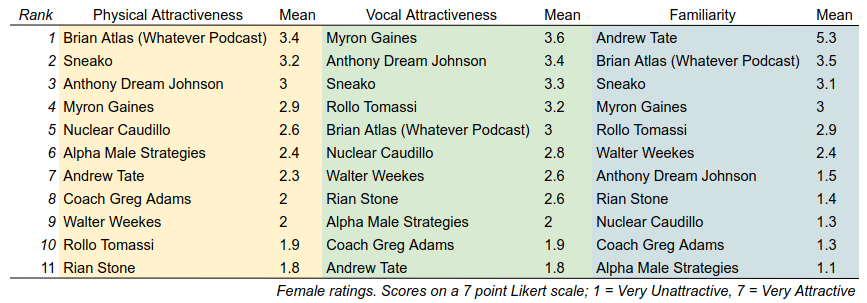
Sex Differences in Red Pill Influencer Attractiveness Ratings
Below are 11 histograms showing sex differences in ratings of the physical attractiveness of individual red pill influencers. For every influencer, men rated red pill influencers as more attractive than women did. Effect sizes are medium to large for most influencer ratings. Means, medians, effect sizes, and p-values are reported in the chart subtitles. A final chart shows the sex difference in total attractiveness ratings across all influencers (p < .001, d = .94).
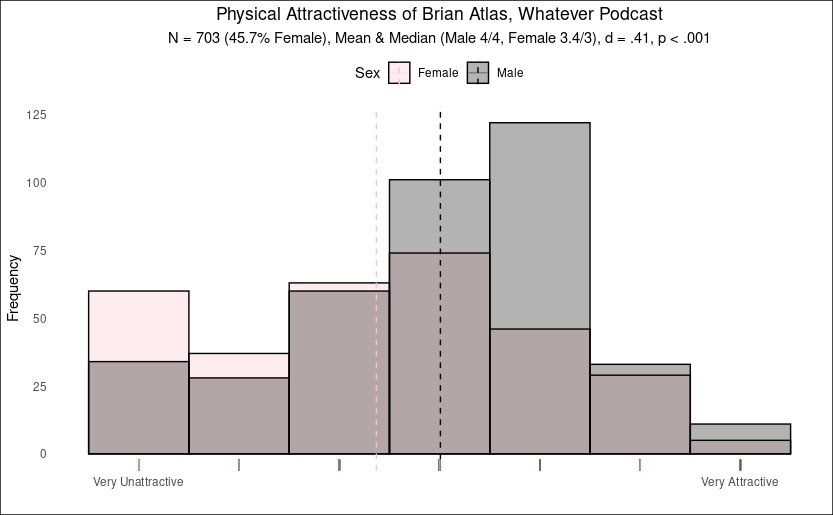
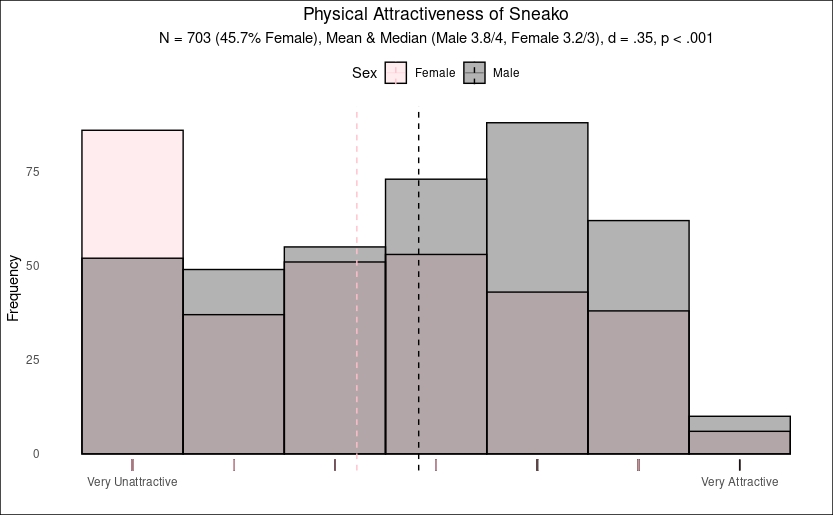
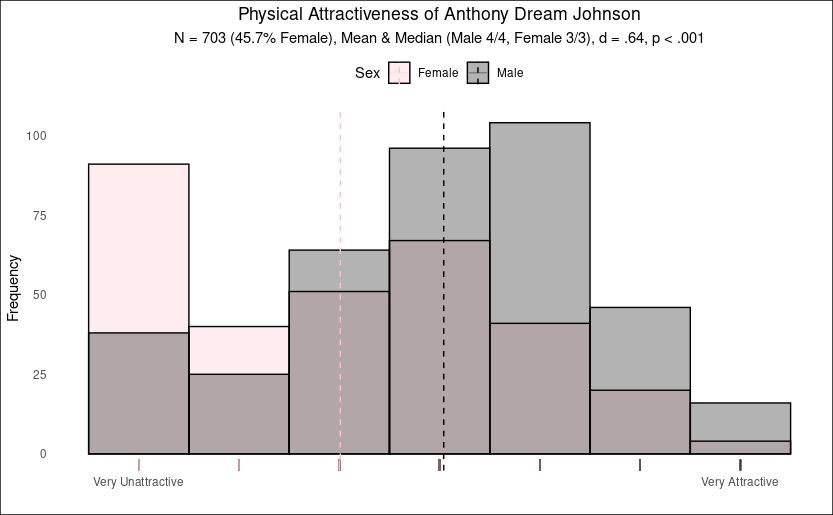

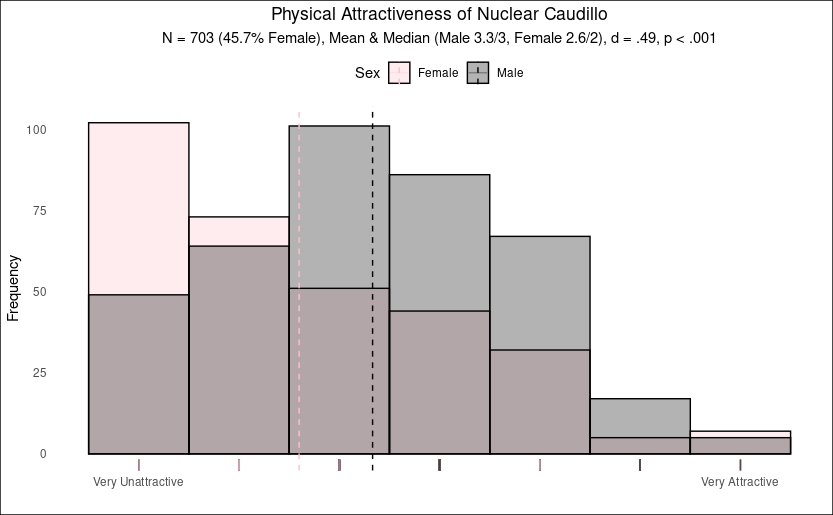
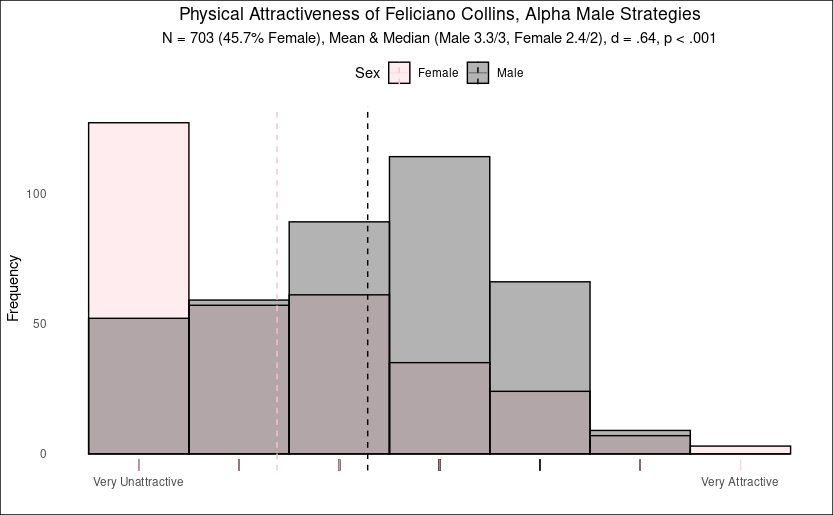
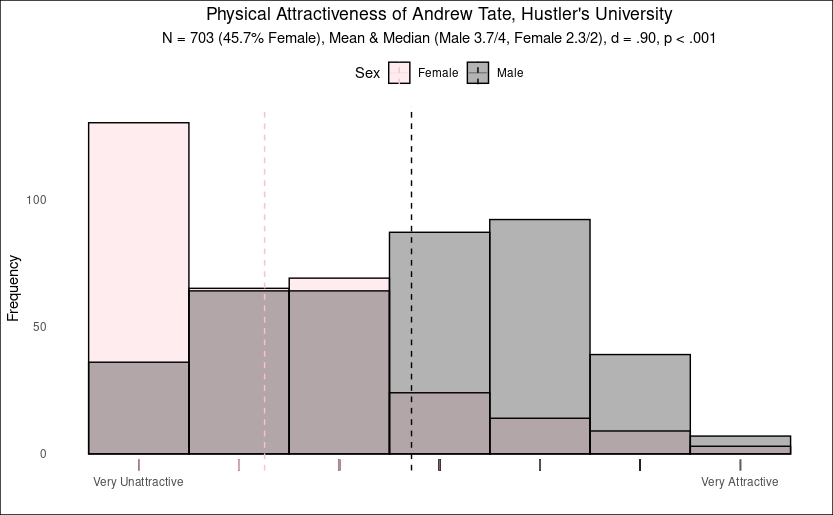
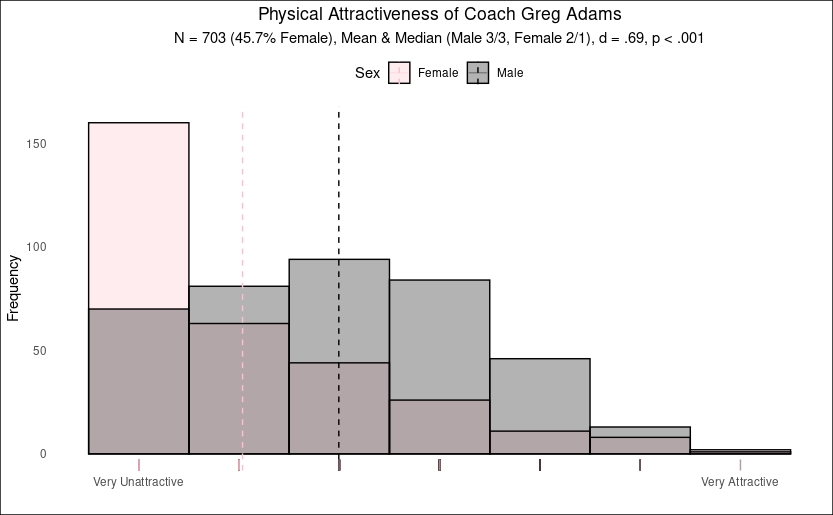
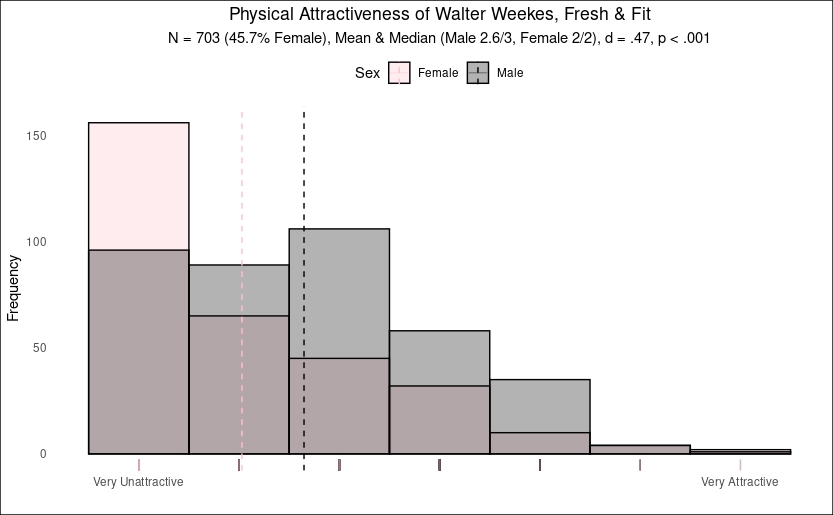
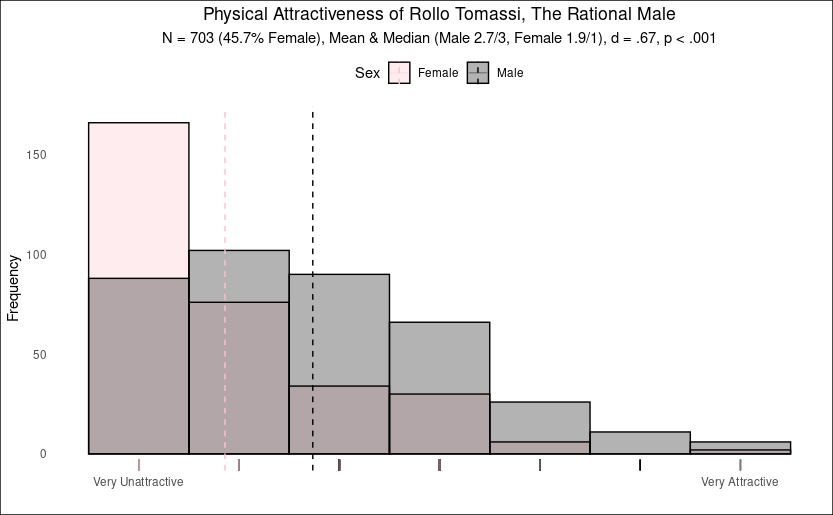
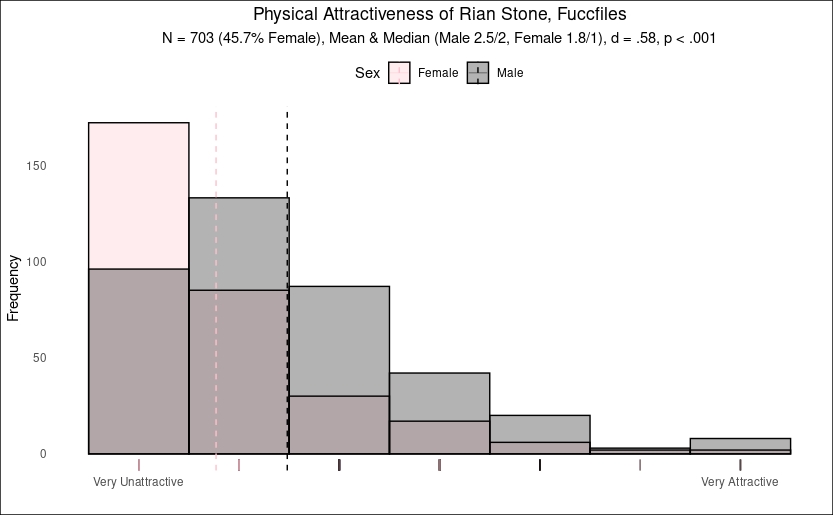

The Halo Effect: Associations with Red Pill Influencer Attractiveness Ratings
I ran a multiple regression with the variables for influencer familiarity (how well the influencer was known to the rater), redpill attitudes (did participants have positive or negative attitudes toward the red pill), blackpill attitudes, left-right political ideology, feminist identification, traditionalist identification, and Christian identification.
The regression was significant (F(7, 709) = 23.16, p < .001). Approximately 17.81% of the variance in physical attractiveness was accounted for by the predictor variables.
Redpill attitudes had a significant positive relationship with physical attractiveness ratings (β = 2.94, p < .001). The more participants viewed the red pill positively, the higher the attractiveness rating they gave to red pill influencers on average.
Political ideology had a significant negative relationship with attractiveness ratings (β = -1.16, p < .001), indicating that a stronger right-wing political identification was associated with lower attractiveness ratings given to red pill influencers.
Feminist identification was also significantly associated with attractiveness ratings (β = -0.74, p < .01). Participants who were more feminist gave lower ratings to red pill influencers.
Familiarity of the influencer, attitudes toward the black pill, traditionalist identification, and Christian identification did not show significant associations with attractiveness ratings.
Below are Spearman’s rank order correlations for redpill attitudes and feminist identification with total attractiveness ratings.
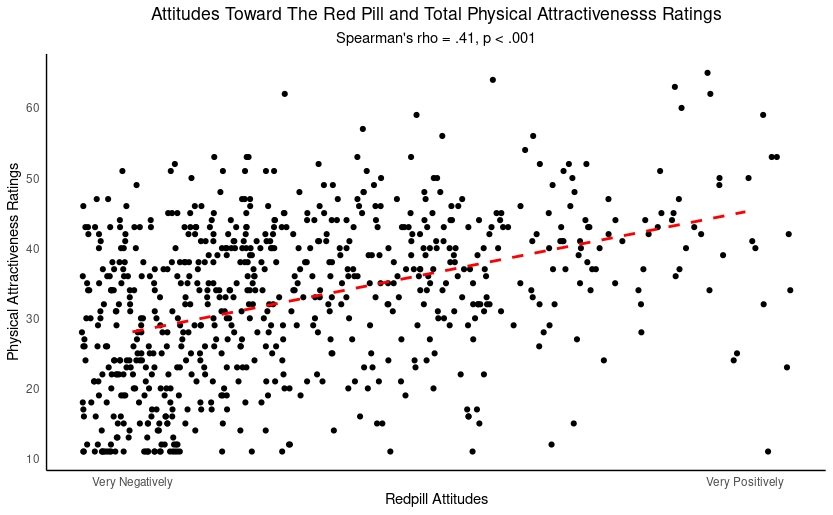
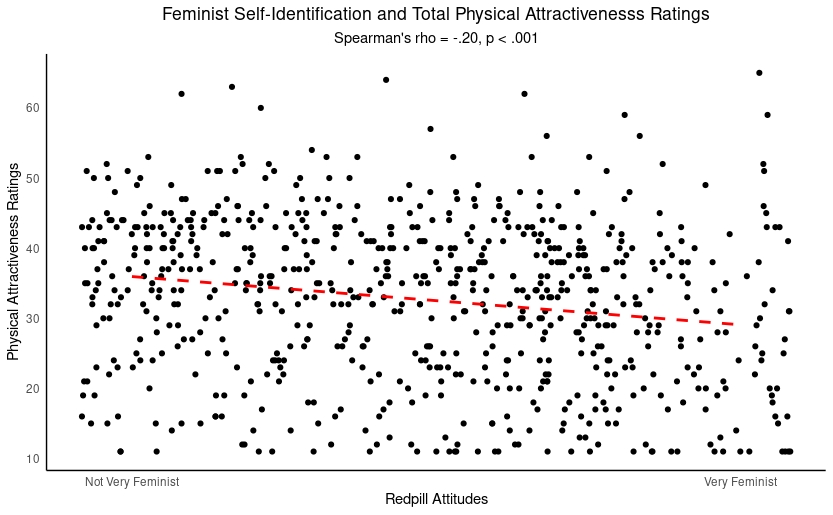
The moderate association of positive attitudes toward the red pill and higher attractiveness ratings provides evidence for the bidirectional nature of the Halo Effect. Participants who viewed the red pill positively were more likely to give higher ratings while participants who viewed the red pill negatively were more likely to give lower ratings. However, there was no effect of familiarity; participants who were more familiar with red pill influencers were not more likely to rate them as more or less attractive.
Participants were also asked “are you redpilled” and I performed a nonparametric Kruskal-Wallis test to examine differences in attractiveness ratings between the three response groups. There was a significant difference across groups (χ²(2) = 17.722, p < .001).
A Dunn’s test with Bonferroni correction found a significant difference between “Yes” and “No” groups (mean dif = -4.2, p < 0.001) and between the “Yes” and “Other” groups (mean dif = -2.6, p = 0.014). However, no significant difference was found between the “No” and “Other” groups (mean dif = -0.350, p = ns).
Although these differences were significant they were small (η2 = .02) and this can be visualized in the violin plot below:
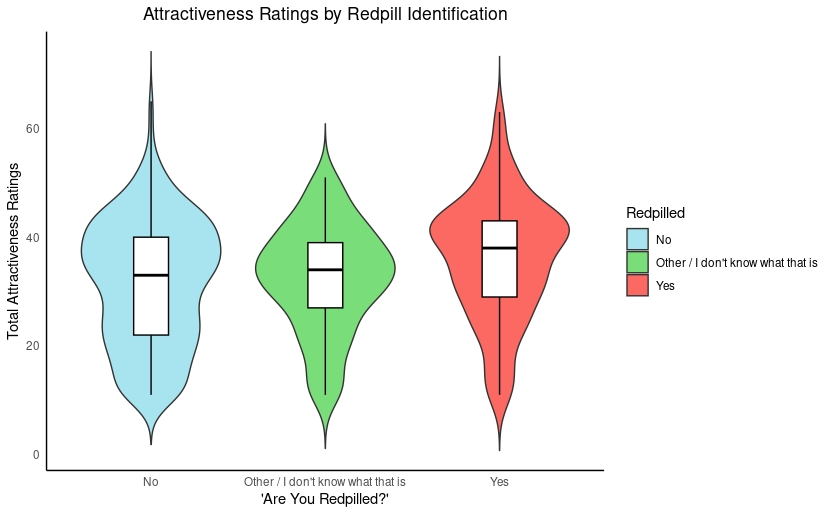
I also asked participants “are you blackpilled” and “are you an incel.” Blackpill identification was not associated with attractiveness ratings (χ²(2) = 2.505, p = .286), however incel identification was (χ²(2) = 8.254, p = .016). This difference was only significant for the “Yes” and “No” groups (mean dif = -2.9, p = .006) after the Dunn’s test with Bonferroni correction. Once again the difference was small (η2 = .012).
Below are violin plots for blackpilled and incel groups:
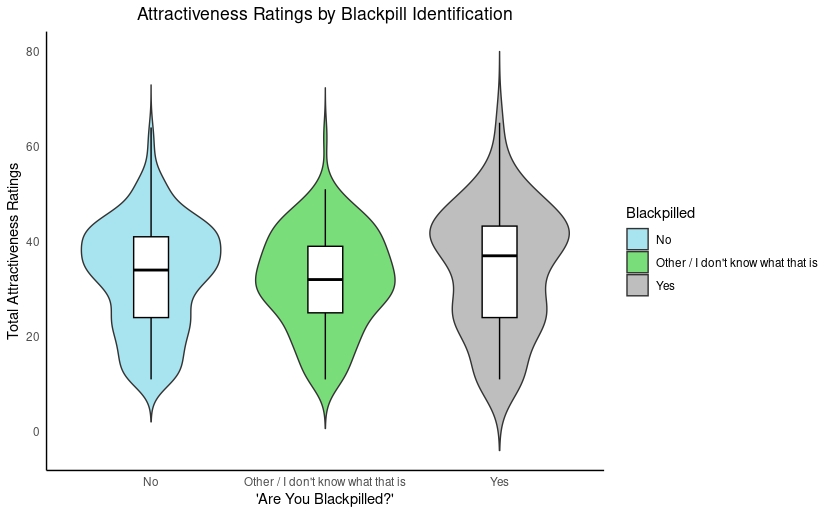
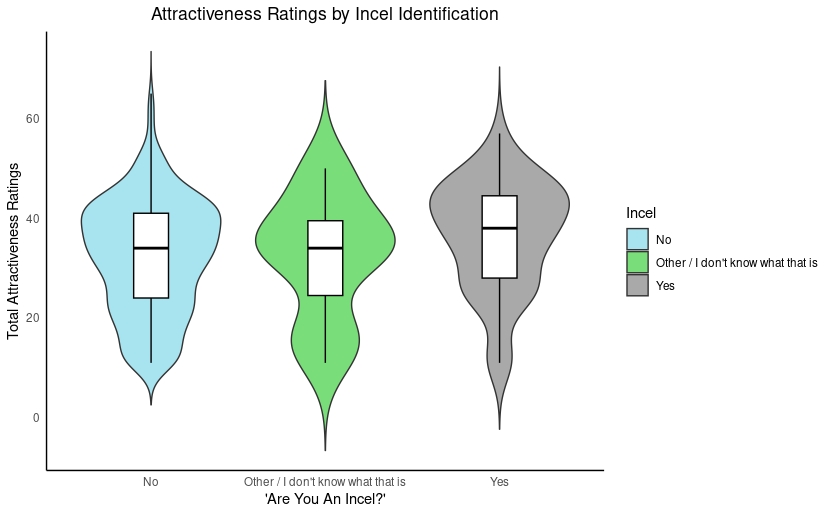
Overall these results show small-to-moderate effects of bias in ratings of red pill influencers. Participants who view the red pill more favorably, or who identify as redpilled, blackpilled, or incels, are only a little more likely to rate red pill influencers as more attractive.
Sexual Partners, Dating App Success, and Red Pill Identification
Participants were asked if they were redpilled, to which they could respond “Yes,” “No,” or “Other / I don’t know what that is.” Participants also indicated their lifetime number of sexual partners and self-assessed success on dating applications.
Red Pilled Men, Sexual Partners
A Kruskal-Wallis test showed a significant difference between groups (χ²(2) = 6.5881, p = .04). Dunn pairwise comparisons with Bonferroni correction indicated that the “Yes” group was significantly lower than the “Other / I don’t know what that is” group (z = -2.3, p = .03). The difference between the “Yes” and “No” groups did not reach statistical significance (z = -0.04, p = 1). The “Other / I don’t know what that is” group was also not significantly different from the “No” group (z = -1.64, p = .152).
These results show that red pilled men did not have a higher number of lifetime sexual partners.
The first series of boxplots below show differences by group for sexual partners restricted to a range of < 100 while the second series of boxplots shows differences by group for sexual partners restricted to a range of < 20.


Red Pilled Men, Dating App Success
There was a significant difference in the distribution across the three groups (χ²(2) = 9.4775, p = .008). A Dunn’s test with corrections found the “Other / I don’t know what that is” group was significantly lower than that in the “No” group (z = -3.02, p = .004). There was no significant difference between the “Yes” group and the “No” group (z = -0.22, p = 1). The “Yes” group was significantly higher than the “Other / I don’t know what that is” group (z = 2.67, p = .011).
These results show that red pilled men did not perform better on dating apps.

Participants were also asked how positive or negative they viewed the red pill. A Spearman’s correlation revealed no significant association between red pill views and dating app success (rho = -0.04, p = .378).
Red Pill Influencers and Vocal Attractiveness
A Pearson’s correlation revealed a large and significant positive association between vocal attractiveness and physical attractiveness for red pill influencers (r = .84, p < .001).

A multiple regression was performed for vocal attractiveness onto familiarity, red and black pill attitudes, political ideology, feminist identification, traditionalist identification, and Christian identification. The regression model was significant (F(7, 709) = 23.05, p < .001) and accounted for approximately 17.7% of the variance in vocal attractiveness scores. Similar to physical attractiveness, attitudes toward the red pill were the strongest predictor (b = 2.84, t(709) = 9.75, p < .001). Feminist identification (b = -0.60, t(709) = -2.22, p = 0.027), showed a smaller but significant association, the remaining variables did not reach statistical significance.
Finally here is a correlation matrix for variables used in this dataset:
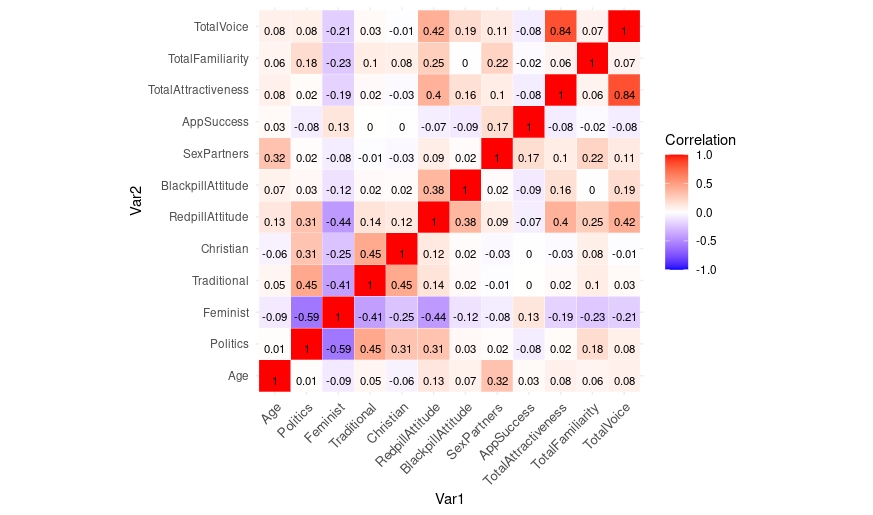
Result Summary
- Top red pill influencers were rated generally low in both physical and vocal attractiveness. Lower ratings were given to red pill influencers by women than by men.
- Positive attitudes toward the red pill were associated with higher ratings of physical and vocal attractiveness. However, variables influencing attractiveness ratings explained only a modest portion of the variance in ratings.
- Redpilled men did not have more sexual partners on average, nor did they report greater success with dating apps.
- The vocal and physical attractiveness of red pill influencers was highly correlated.
Discussion
Sex differences and positive attitudes toward targets both shape perceptions of physical attractiveness. Across the literature, women are more inclined to give lower ratings of attractiveness to men than other men give. Additionally, if a subject is perceived negatively by raters then he will also be seen as less physically attractive.
In my results, the association of popular influencers with the red pill resulted in their assessment as less attractive by participants who viewed the red pill more negatively.
However, attitudes toward the red pill only explained a modest portion of the variance in attractiveness ratings. We cannot conclude that the very low ratings of red pill influencers occurred “only” because they were stereotyped negatively. Men and women both consistently rated red pill influencers low in physical and vocal attractiveness.
Past research has found correlations between facial and vocal attractiveness, however the high correlation in my results is likely due to faces and voices being presented concurrently. Influencers who are perceived more positively in general may be perceived more positively across the two variables. Additionally, vocal attractiveness may influence raters’ perceptions of physical attractiveness and vice versa.
Finally, men who identified as redpilled did not report more success on dating apps nor more lifetime sexual partners.
This was, to date, the most controversial survey I have run. The backlash I received from this from the red pill community dwarfed even the feminist response to our survey that asked if having sex with a sleeping person was really sexual assault.
It’s hard to describe the redpilled responses as anything other than extremely fragile, but at the end of the day the results can be interpreted to vindicate the red pill over the black pill. Here we have a list of popular red pill influencers, many of whom are very low in physical attractiveness, but who nonetheless claim to be highly successful with women. If you believe that their claims are true then you must conclude they have found something that has helped them overcome their shortcomings in the looks department.
However, the results from redpilled participants do not necessarily support this conclusion. I didn’t find that they were more successful with women across the measurements of dating app success and lifetime sexual partners. This could be interpreted in different ways. These men could have done worse before finding the red pill, only for redpilled dating discourse to help them reach parity with normal men. This would be consistent with past research on red pill communities that has found men enter these spaces after having bad romantic experiences with women.
Alternatively, the red pill may be a placebo pill that does not help men at all.
2 comments
Interesting read! It’s fascinating to see how the Red Pill movement has gained traction online, and how influencers in this space have been able to build such large followings. I’m curious to see how the ratings and opinions of these influencers compare to those of other leaders in the dating and relationships space. Do you think there’s a market for Red Pill-style content in the long term, or do you think it’s a fad that will eventually fade away?
Why didn’t you use a control group? Most men are physically unattractive to women. Are redpillers significantly less attractive than average ?